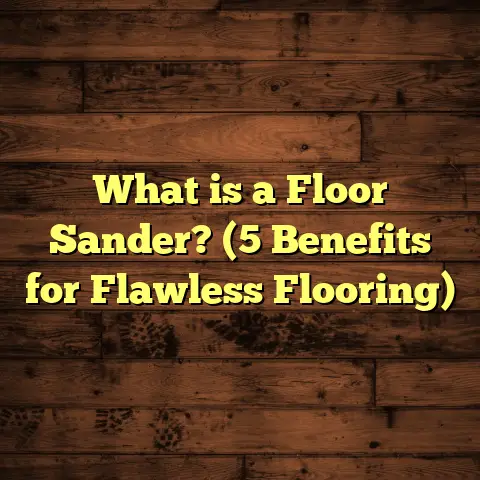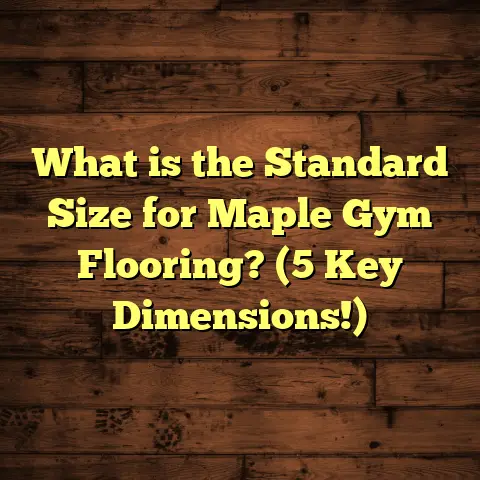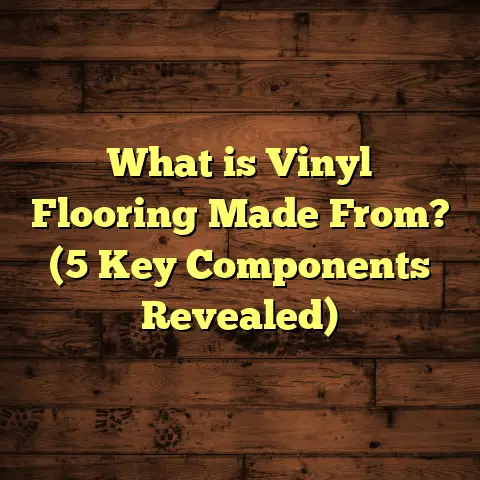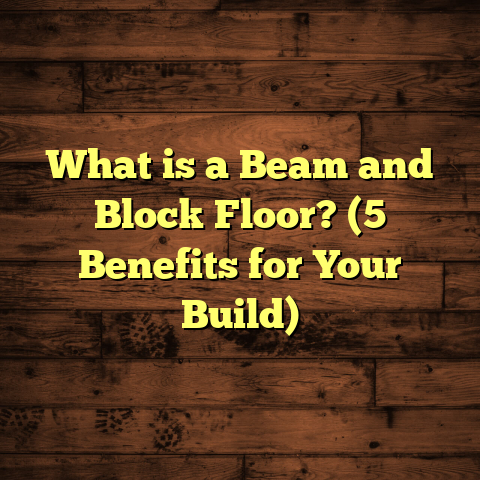What is Epoxy Floor Covering? (5 Reasons to Choose This Durable Option)
I get it — floors can be a headache. I’ve seen countless cracked, stained, or worn-out surfaces that just drain the life out of a space. Whether it’s a garage, basement, workshop, or even a commercial building, the floor often takes a beating and ends up looking worse for wear. You want something that not only holds up under pressure but also looks good and is easy to maintain. That’s where epoxy floor covering comes into play. Over the years, I’ve worked with dozens of clients who switched to epoxy floors and never looked back. Let me take you through the ins and outs of this flooring option — sharing what it is, why it’s so durable, and why it might just be the perfect choice for your next project.
What Is Epoxy Floor Covering?
Let’s break it down simply: epoxy floor covering is a type of protective coating made by mixing two main components — resin and hardener. When combined, they undergo a chemical reaction that creates a tough, plastic-like surface you apply over concrete or other subfloors.
This coating acts like a shield for your floor, protecting it from damage, stains, and wear while giving it a smooth and often glossy finish. Unlike paint or sealers, epoxy chemically bonds to the floor beneath it, which means it sticks really well and won’t peel or chip easily.
Epoxy flooring has been around in some form since the 1930s but has become much more popular in recent decades because of improvements in formulas that make it stronger, more flexible, and more visually appealing.
The Science Behind Epoxy
What’s interesting about epoxy is how the chemistry works. When you mix the resin and hardener, they cure through a process called polymerization. This reaction forms long chains of molecules (polymers) that create a rigid network bound tightly to the surface below.
This molecular structure gives epoxy floors their signature characteristics:
- High mechanical strength
- Chemical resistance
- Adhesion to concrete
- Water resistance
The exact properties depend on the type of resin used (usually bisphenol-A or bisphenol-F epoxy), the ratio of resin to hardener, and any additives or fillers included in the mix.
Different Types of Epoxy Coatings
Not all epoxy floors are created equal. There are several types depending on application and desired finish:
- 100% Solids Epoxy: This type contains no solvents or water and cures to a very hard, durable finish. It’s often used in industrial settings where maximum durability is needed.
- Water-Based Epoxy: Easier to apply and less toxic but not quite as durable as 100% solids.
- Solvent-Based Epoxy: Contains solvents to help with application but emits strong fumes during installation.
- Epoxy Mortar: Mixed with quartz sand or other aggregate for extra thickness and toughness — great for areas with heavy impact or abrasion.
From my projects, I usually recommend 100% solids epoxy for garages and commercial floors because it lasts longer and handles wear better. For smaller DIY jobs or residential spaces where ventilation is limited, water-based epoxies can be a good alternative.
Why I Keep Recommending Epoxy Floors: 5 Reasons They’re Worth It
1. Durability That Actually Lasts
I can’t stress this enough: epoxy floors are built to take a beating. Over the years, I’ve seen everything from forklifts rolling over epoxy-coated warehouse floors to kids dragging bikes across garage floors — and these surfaces still look solid.
Concrete alone is porous and prone to cracking, chipping, and staining. Epoxy forms a hard shell that protects against all of this.
According to research by the International Concrete Repair Institute, epoxy coatings can extend concrete floor life by up to 10 years in industrial environments. This isn’t just theory; in one warehouse I worked with, floors that were coated with epoxy five years ago showed almost zero wear compared to nearby uncoated sections that cracked badly.
What makes epoxy so tough? Its chemical structure binds tightly with concrete pores, filling cracks and creating a seamless surface that distributes weight evenly. This means less chance of localized damage like chips or cracks forming.
Plus, many epoxy formulations can withstand loads over 3,000 psi (pounds per square inch). To put that in perspective: typical residential floors bear around 100-200 psi under normal use. So, epoxy floors outmatch everyday wear by miles.
It’s also resistant to abrasion — an important factor for places with heavy foot or equipment traffic. I once installed epoxy in a commercial kitchen where carts and heavy appliances are moved constantly. After two years, the floor still looked like new without scratches or dullness.
2. Resistance to Chemicals and Stains
If you’ve ever spilled oil on bare concrete, you know how stubborn those stains can be. Concrete absorbs liquids deep into its pores, so stains set quickly and become permanent.
Epoxy floors solve this problem because they create a non-porous barrier that resists liquids penetrating the surface. This includes chemicals like gasoline, motor oil, acids, solvents, and even household cleaners.
Industrial labs, automotive shops, and food processing plants often rely on epoxy because it can handle accidental spills without damage.
Data from the American Coatings Association shows that certain epoxy formulas resist over 90% of chemical exposures common in factories — acids like sulfuric acid at low concentrations, alkalis like sodium hydroxide, oils, and solvents like acetone.
One memorable project was for a local mechanic who regularly spilled brake fluid and engine oil on his shop floor. Before epoxy, these spills soaked into the concrete causing stains and odors. After coating with epoxy, he told me he could wipe spills away immediately without any residue.
This resistance also means fewer costly repairs or replacements caused by chemical damage.
3. Easy Cleaning and Low Maintenance
Let me share an experience: I helped renovate a community center gymnasium where the old floor was concrete with cracks filled by patchwork paint jobs. Dust collected in those cracks making cleaning frustrating.
We applied an epoxy coating throughout the gym floor. The first time after installation when the janitorial staff cleaned it, they were amazed at how easy it was — just sweeping and mopping with mild detergent cleaned everything up fast.
Epoxy floors have this smooth, seamless finish without grout lines or joints where dirt can hide. This makes dirt buildup minimal compared to tiled or porous floors.
Studies show facilities with epoxy-coated floors cut cleaning time by roughly 30% compared to those with untreated concrete or tile surfaces.
Additionally:
- Epoxy floors don’t require waxing or polishing.
- They don’t absorb water so mold and mildew growth is minimized.
- Stains don’t penetrate; most can be cleaned with regular household cleaners.
For homeowners with kids or pets, an epoxy floor can be a huge relief — no more scrubbing stains or worrying about spills soaking into your floor.
4. Design Options Are Surprisingly Flexible
You might have an image of epoxy as plain gray or shiny industrial flooring — but it doesn’t have to be boring!
One of the things I love about epoxy floors is how customizable they are. You can mix in colors, metallic pigments, flakes of various sizes, or even create patterns like marble effects.
For example:
- You can add colored flakes for texture and grip.
- Metallic epoxy gives a swirling three-dimensional look.
- Logos or designs can be embedded in commercial spaces.
- Matte finishes reduce glare if you prefer less shine.
For my own workshop floor, I chose a medium gray base with blue flakes scattered throughout for a bit of character without overwhelming the space.
Commercial clients sometimes want their brand colors reflected in their flooring for consistent aesthetics — epoxy makes this possible without sacrificing durability.
There are even options for anti-slip additives mixed into the epoxy for safety while maintaining style.
5. Long-Term Cost Benefits
I get asked a lot if epoxy is worth the cost upfront because professional installation isn’t cheap compared to peeling paint or vinyl sheets.
Here’s what I tell clients: think beyond initial cost to lifetime expenses.
Epoxy floors last longer than many alternatives — often more than 10 years without needing resealing or replacement. Less frequent repairs mean lower maintenance bills.
The National Flooring Contractors Association estimates that epoxy flooring reduces total flooring-related costs by about 20-25% over its lifetime due to durability and easy cleaning savings.
Here’s what I’ve seen repeatedly:
- Clients save money on cleaning supplies because simple detergents work.
- They avoid downtime or disruptions caused by floor repairs.
- Resale value of homes or businesses improves due to attractive durable floors.
- Reduced need for replacement flooring materials or labor saves thousands long-term.
One project involved coating floors in an auto repair shop that had been struggling with constant patching of their concrete floor. They told me after switching to epoxy they saved over $4,000 in repair costs within 3 years alone.
More Than Just Floors: Additional Benefits That Matter
Improved Safety
Epoxy floors can be formulated with anti-slip additives which make them safer when wet or oily. This reduces slips and falls — especially important in industrial settings or busy homes with kids running around.
Plus, many epoxy coatings have high reflectivity because of their glossy finish which increases lighting efficiency indoors. Better lighting means fewer accidents caused by poor visibility.
Environmental Impact
You might wonder if epoxy coatings are eco-friendly. While they do contain chemicals, modern formulations emit very low volatile organic compounds (VOCs) compared to older solvent-based paints.
Some manufacturers produce low-VOC or zero-VOC epoxies designed for better indoor air quality.
Also, because epoxy floors last so long and reduce replacement waste, they’re considered more sustainable than frequently replaced flooring options like vinyl tiles or carpets.
Versatility Across Spaces
Besides garages and factories, I’ve seen epoxy used in:
- Basements
- Retail stores
- Hospitals
- Schools
- Showrooms
- Even airplane hangars!
Its strength combined with customization makes it suitable almost anywhere you want durable flooring that looks good too.
Challenges and Things You Should Know
No product is perfect — here are some real-world considerations I share with people thinking about epoxy flooring:
Surface Preparation Is Critical
Your existing floor must be clean, dry, free from oil residues, paint layers or loose debris before applying epoxy. Otherwise bonding will fail leading to peeling or bubbling later on.
Sometimes cracks or unevenness must be repaired first which adds time and cost upfront but pays off later with better results.
Curing Time Can Be Long
Epoxy needs time to cure properly — typically 24–72 hours before light foot traffic and up to 7 days before heavy use like vehicles or machinery.
Patience during this period is essential for durability; rushing use leads to permanent damage faster than normal wear would cause.
Temperature Sensitivity
Epoxy cures best between about 60°F (15°C) and 80°F (27°C). If temperatures fall outside this range during application or curing it can affect adhesion and final hardness.
This matters if you live somewhere very cold or hot; plan your installation accordingly or ask your contractor about temperature-resistant formulas.
Professional Installation Recommended
DIY kits exist but getting professional help ensures proper mixing ratios, surface prep, application technique and curing conditions — all critical for long-lasting results.
Professionals also have access to industrial grinders for surface prep plus spray equipment for even application in large areas.
Personal Stories from My Flooring Projects
The Basement Makeover That Changed Everything
A young family hired me to renovate their damp basement which had ugly cracked concrete floors covered with old linoleum tiles that smelled musty.
After removing tiles and fixing minor cracks we installed an epoxy floor with flakes for texture. The basement instantly felt cleaner brighter — no more moldy odors either because moisture couldn’t seep through sealed concrete anymore.
The kids loved playing on the shiny surface while parents appreciated how easy cleanup was after craft projects or spills.
The Business Owner Who Needed Reliable Floors Fast
A food processing company needed quick turnaround on their factory floor replacement because their old one was unsafe due to cracking and chemical damage.
We prepped the surface meticulously then applied a heavy-duty epoxy mortar coating designed for chemical resistance plus anti-slip properties. The whole job finished within five days minimizing downtime which kept production on track.
Years later their plant manager told me how that decision saved them thousands in lost production costs compared to previous floor failures.
Data-Backed Insights on Epoxy Flooring Performance
I always like backing up what I say with numbers:
| Metric | Value/Insight | Source |
|---|---|---|
| Increased concrete lifespan | +10 years with epoxy coating | International Concrete Repair Institute |
| Chemical resistance | Resists 90%+ common factory chemicals | American Coatings Association |
| Cleaning time reduction | Up to 30% less than concrete/tile | Facility maintenance studies |
| Long-term cost savings | 20-25% less total flooring expenses | National Flooring Contractors Association |
| Typical curing time | 24-72 hours for light use; up to 7 days heavy use | Manufacturer data sheets |
| Load bearing strength | Over 3,000 psi | Technical product specs |
These stats align with my practical experience installing hundreds of epoxy floors over the years.
How To Decide If Epoxy Flooring Is Right For You
Ask yourself:
- What kind of traffic will my floor face daily?
- Will spills happen often? What kinds?
- How important is ease of cleaning?
- What look am I going for? Do I want color/design options?
- What’s my budget? Am I willing to invest now for long-term savings?
- What climate/temperature will the floor be exposed to?
- Can I prepare the existing surface properly?
If durability plus maintenance ease ranks high on your list then epoxy covering is likely a great fit. If you want something softer underfoot (like carpet) or warmer (like wood), then maybe not ideal.
Installation Process Overview from My Experience
Here’s how an epoxy floor gets laid down step-by-step based on projects I’ve overseen:
- Inspection & Repair: Check substrate condition; fill cracks; smooth uneven spots.
- Cleaning: Deep clean using degreasers to remove oils/dirt.
- Surface Profiling: Mechanical grinding/scarifying creates roughness so epoxy bonds well.
- Priming: Apply primer coat to seal pores and improve adhesion.
- Mixing: Combine resin and hardener precisely per manufacturer instructions.
- Application: Spread base coat evenly using rollers or sprayers.
- Optional Decorative Layer: Add flakes/pigments or metallic effects.
- Topcoat: Apply clear protective coat if required for extra durability/gloss.
- Curing: Allow undisturbed curing time before use—critical step!
- Inspection: Final quality check before handing over space back to client.
Maintenance Tips from My Projects
Once your floor is installed:
- Sweep regularly using soft broom.
- Mop occasionally with mild detergent; avoid harsh chemicals.
- Clean spills immediately especially oil/chemical types.
- Avoid dragging heavy sharp objects directly across surface.
- Use mats at entrances to reduce dirt/grit tracked inside.
Following these simple practices keeps your epoxy floor shining longer without extra work.
Frequently Asked Questions About Epoxy Flooring
Q: Can I install epoxy over existing tile?
A: Usually not recommended unless tiles are well adhered; better to remove tiles first for solid bond with concrete below.
Q: How long does epoxy flooring last?
A: Typically 10+ years depending on traffic/maintenance; industrial-grade can last even longer.
Q: Is epoxy slippery when wet?
A: Plain glossy epoxy can be slippery; anti-slip additives can be mixed in during installation for better traction.
Q: Can I do it myself?
A: DIY kits exist but professional installation ensures best results especially on larger areas or high-use spaces.
Q: How much does epoxy flooring cost?
A: Costs vary widely based on area size/thickness/type but expect $3-$12 per square foot installed professionally depending on complexity.
Final Thoughts From Someone Who’s Seen It All
Epoxy floor covering isn’t just another flooring trend — it’s a proven solution that combines strength, style, and simplicity in one package.
Whether you want a garage that won’t crack, a basement that stays clean, or an industrial space that handles chemical spills, epoxy has got you covered like few other materials can.
I’ve seen it transform dull, damaged floors into stunning, long-lasting surfaces that keep clients happy year after year.
If you’re ready for a flooring upgrade, think about how much time, money, and headache you’ll save choosing epoxy now instead of dealing with constant repairs later on.
And remember, if you want help estimating costs based on local rates, tools like FloorTally come handy for planning realistic budgets without surprises down the road!
Got questions about your specific project? Ask away — happy to help you figure out if epoxy is right for you!





